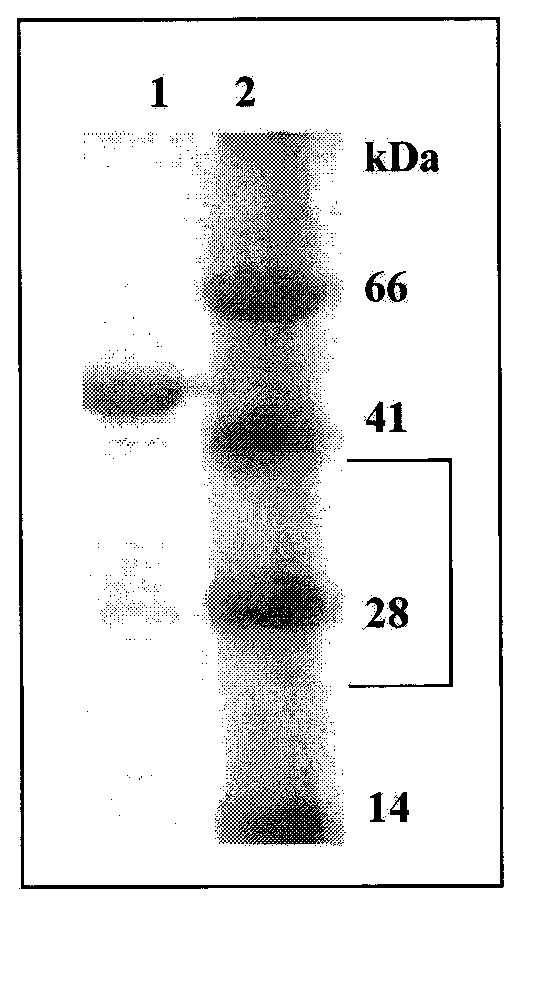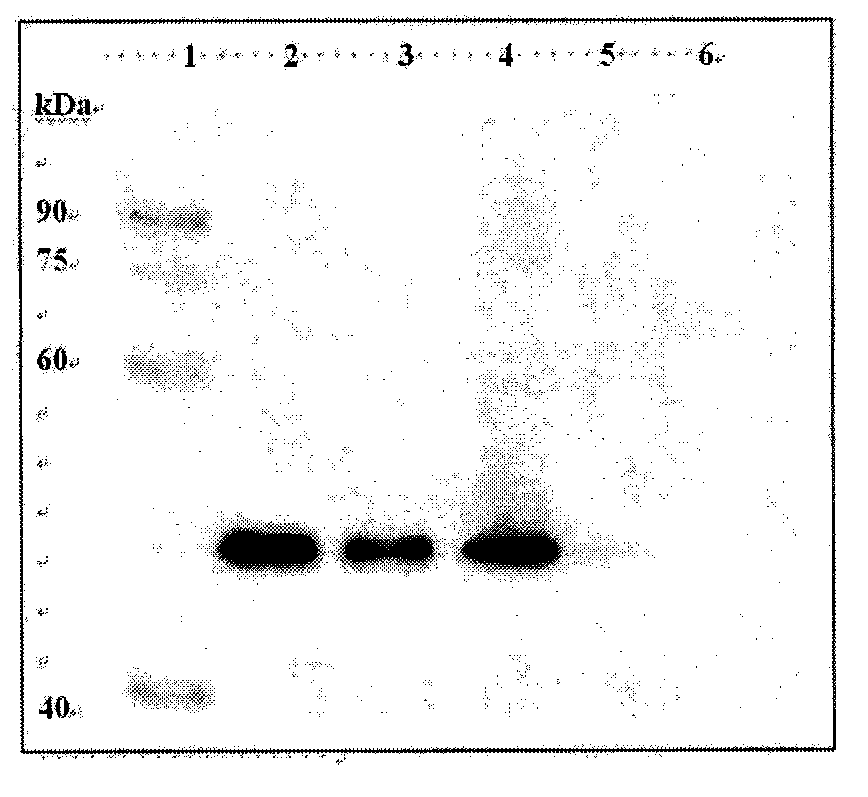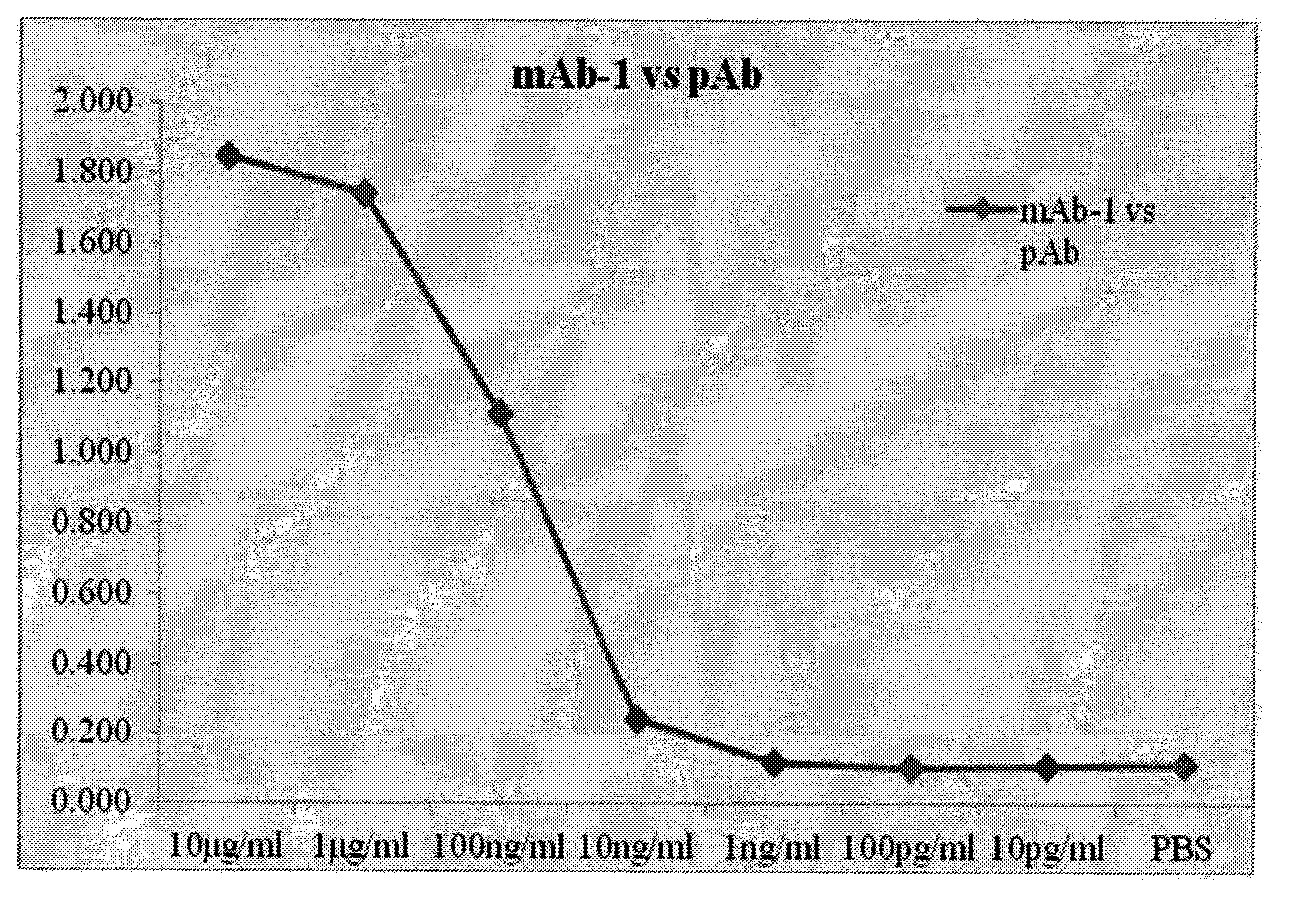Preparation method, coding sequences and use of anti-CP4 5-enolpyruvyl-shikimate-3-phosphate synthase (EPSPS) monoclonal antibody
A monoclonal antibody and sequence technology, applied in anti-enzyme immunoglobulins, measuring devices, instruments, etc., can solve the problems of difficult to popularize and use, high price, etc., and achieve the effect of high use value, high specificity and sensitivity
- Summary
- Abstract
- Description
- Claims
- Application Information
AI Technical Summary
Problems solved by technology
Method used
Image
Examples
Embodiment 1
[0023] Example 1 Preparation of recombinant Cry1A protein
[0025] According to the published gene coding sequence of CP4 EPSPS (Genbank Accession No.AF464188), design specific upstream primer (SEQ ID No.3) and downstream primer (SEQ ID No.4) from Roundup Ready (RR) transgenic soybean DNA standard The CP4 EPSPS gene was amplified, and NcoI and BamHI restriction sites were added to the 5' and 3' ends of the fusion protein gene by PCR. The PCR product was separated by agarose gel electrophoresis and recovered. The recovered fusion protein gene and the plasmid vector pET-BPI used for expression were digested with NcoI and BamHI respectively, recovered by electrophoresis again, and ligated with T4 DNA ligase. The ligation product was transformed into Escherichia coli competent cell BL21, the clones on the plate were picked and inoculated, the plasmid DNA was extracted and identified by PCR. PCR showed that the fusion protein gene positive clones were seque...
Embodiment 2
[0028] The establishment of embodiment 2 hybridoma cell lines
[0029] 1. Immunity
[0030] The cross-linked polypeptide in Example 1 was emulsified with complete Freund's adjuvant (Sigma Company), immunized 4-6 weeks old female Balb / c mice (provided by the Academy of Military Medical Sciences), and injected subcutaneously into each mouse at 6 o'clock in the abdomen. , the dose is 60μg / only. Immunization was boosted every 14 days, and the antigen was emulsified with Freund's incomplete adjuvant (Sigma Company) at a dose of 30 μg per mouse. 7 days after the third booster immunization, indirect ELISA (wavelength 450nm) was used to detect the polyantibody titer of the anti-immunogen in the mouse serum. 50μg / only.
[0031] 2. Cell Fusion
[0032] The mouse splenocyte suspension meeting the immune standard was aseptically prepared, mixed with mouse myeloma cell sp2 / 0 (ATCC) at a ratio of 5:1, and centrifuged at 1500 rpm for 5 min. After the supernatant was discarded, the centr...
Embodiment 3
[0037] Example 3 Preparation of Monoclonal Antibody by Ascites Induction Method
[0038] 1. Ascites preparation
[0039] Cells in the logarithmic growth phase were washed with serum-free medium and suspended, counted to 5×10 5 , 1ml. The suspended cells were injected intraperitoneally into mice previously sensitized with paraffin oil. Ascites collection was started 7 days later. The removed ascites was centrifuged at 4000rpm for 10min at 4°C. Carefully suck out the ascites in the middle and collect in a centrifuge tube, and store at 4°C or -20°C.
[0040] 2. Purification of monoclonal antibodies
[0041] Antibody was purified from ascitic fluid by HiTrap rProtein A FF (GE Company) affinity chromatography according to the instructions. The purity was identified by SDS-PAGE gel, and the concentration was determined by Bradford method. Purified antibodies were stored at -20°C.
PUM
 Login to View More
Login to View More Abstract
Description
Claims
Application Information
 Login to View More
Login to View More - R&D
- Intellectual Property
- Life Sciences
- Materials
- Tech Scout
- Unparalleled Data Quality
- Higher Quality Content
- 60% Fewer Hallucinations
Browse by: Latest US Patents, China's latest patents, Technical Efficacy Thesaurus, Application Domain, Technology Topic, Popular Technical Reports.
© 2025 PatSnap. All rights reserved.Legal|Privacy policy|Modern Slavery Act Transparency Statement|Sitemap|About US| Contact US: help@patsnap.com



